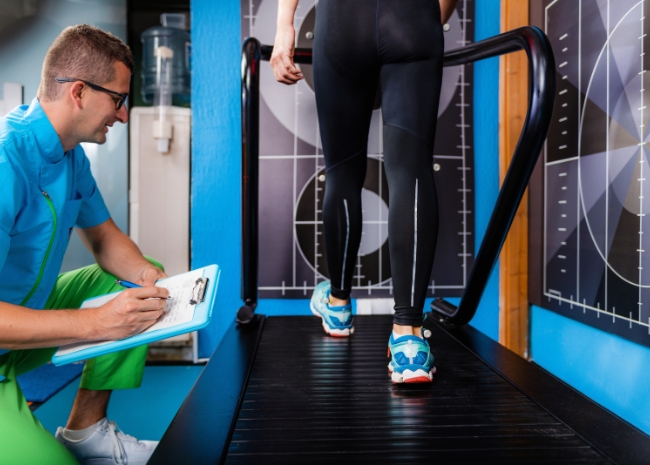
For the full breakdown, watch the webinar above, where gait expert Dr. Doug Adams walks you through the Gait Analysis Cheat Code.
Gait Analysis: Enhancing Patient Outcomes
As physical therapists, one of our main goals is to help patients live active, healthy lives for as long as possible.
And one of the most effective ways we can do this is by focusing on something we all do every day—walking.
Improving gait (the way someone walks or runs) can make a huge difference in reducing pain, preventing injuries, and helping patients stay active for longer.
This article explores:
- The importance of gait analysis,
- The benefits of personalized gait interventions, and
- How the right technology can enhance treatment outcomes.
Why Gait Analysis Matters
If we’re not paying attention to how someone moves, we could be missing some key factors that are holding them back.
Gait analysis:
- Identifies underlying issues: Gait analysis helps pinpoint movement problems that may be contributing to pain or limitations.
- Enables targeted interventions: Once we know where the issues lie, we can create specific interventions to improve movement and reduce injury risk.
- Is essential for an effective treatment plan: Without assessing gait, we may miss critical factors that impact the patient’s recovery.
- Improves patient outcomes: Gait analysis can lead to faster recovery and better long-term results.
- Reduces recovery times: By addressing movement inefficiencies early, patients recover more quickly.
- Enhances quality of life: With better gait, patients can enjoy pain-free, active lifestyles for longer.
Benefits of Personalizing Gait Interventions
Every patient is different, and their treatment plans should reflect that.
A thorough gait analysis helps us identify the specific causes of pain or dysfunction, allowing for more focused interventions.
Steps for Personalizing Gait Interventions:
- Assessment: Begin with a detailed gait assessment to identify issues like abnormal stride, misalignment, or joint imbalances.
- Identify Key Problems: Look for patterns that could indicate specific issues—such as weak muscles or joint instability—and target those areas.
- Design Targeted Interventions: Based on the assessment, create a personalized program focused on correcting the issues found during the analysis. This might include strengthening, flexibility exercises, or movement retraining.
- Monitor Progress: Gait analysis should be an ongoing process. Regularly assess the patient’s progress to adjust the treatment plan as needed.
Personalized gait retraining helps ensure that the patient receives care that addresses their unique needs, leading to faster recovery and better long-term results.
Choosing the Right Technology for Gait Analysis
Technology has made gait analysis more accurate and accessible.
When selecting the right tools for your practice, consider your patient population and the type of data you need to gather.
Types of Gait Analysis Technology:
- 2D Video Analysis: A simple method that uses video to analyze movement patterns. It’s a cost-effective option for many practices.
- 3D Motion Capture: A more advanced system using markers to capture detailed joint movements. This provides precise data but may require more specialized equipment.
- Pressure Sensors and Force Plates: These systems measure the forces applied to the ground during walking or running, giving insight into how weight is distributed during movement.
- Wearable Devices: Small sensors worn by the patient that track gait metrics like cadence, step length, and symmetry. These are great for real-time tracking and long-term monitoring.
The right technology depends on the complexity of the cases you treat and your budget.
A simple video system may be enough for most, but more advanced tools can provide deeper insights for more complex cases.
Key Strategies for Improving Gait and Preventing Injury
When retraining gait, keep these strategies in mind to get the best results:
1) Simplify the Approach
- Rather than aiming for a perfect gait, focus on small improvements.
- For example, reducing stress on the body by just 10% with each step can make a significant difference over time.
- The goal is to reduce the strain on the body, not to perfect every detail.
2) Personalize Retraining Programs
- Every patient’s gait is different, so their treatment should be too.
- Some might need more strength training, others more flexibility work.
- Personalizing the program based on the patient’s specific needs leads to better outcomes.
3) Focus on the Most Critical Issues
- Don’t try to fix everything at once.
- Identify the most important issue—whether it’s knee pain, hip weakness, or foot dysfunction—and prioritize that in treatment.
- Once that issue is addressed, move on to the next.
Final Thoughts
Gait analysis is a powerful tool for physical therapists, enabling us to personalize treatment plans and improve patient outcomes.
By incorporating gait assessments into our practices, using the right technology, and applying a personalized approach to gait retraining, we can help patients recover more effectively, prevent future injuries, and lead healthier, more active lives.
Gait is more than just a simple movement—it’s a vital indicator of overall health, with the power to transform recovery and improve quality of life.
Ready to dive deeper? Check out the full webinar with Dr. Doug Adams for more practical strategies on mastering gait analysis and improving patient care.
Did you find these tips helpful? Let us know! Contact our PT Success Team at ptlighthouse@thejacksonclinics.com
To learn more about The Jackson Clinics and to explore a career with us, please visit thejacksonclinics.com/careers









